Effingham Embree (1759=1817) was the husband of the 4th great grand aunt (Mary Lawrence, 1763-1831) of my wife. He was probably named after his uncle, Effingham Lawrence. The Embrees continued to bestow the name of Effingham on their children down to the present day.
The Businessman
He was a clockmaker, businessman, and land speculator in New York.
He was born in Flushing, but moved to Manhattan to learn the clock making trade.. By 1781 Effingham and Thomas Pearsall were conducting a watch making business together. By 1789 Effingham was in business for himself, making clocks and watches and selling jewelry from his shop at 185 Pearl Street (named Queen Street during the British occupation).
It would be more accurate to call Effingham a clock assembler rather than a maker. Like others in the trade, he purchased parts locally and from England and assembled them in a way to guarantee the accuracy of the movements. Some wooden cases were made locally, others imported. But his name engraved on the dial indicate that he had assembled the clock and guaranteed its accuracy.
A Pearsall and Embree clock
Effingham Embree tall clock in Diplomatic Reception Room of the White House
It was presented in 1976 as as the Bicentennial gift of the Society of Colonial Dames.
Another Effingham Embree tall clock
An Effingham Embree watch with his name engraved on it
A receipt with his signature
Effingham engaged in land speculation. He owned large tracts of unimproved land in New York, Pennsylvania, and Kentucky. Closer to home he bought, divided, and sold land in Manhattan. His deals in 1785 involved the equivalent of about $600,000 in 2015 dollars. He also loaned money. Lawsuits for unpaid loans indicate the scale of his transactions: one was for $200,000 in 2015 dollars.
Effingham invested in the Tontine Coffee House, which provided a home for the fledgling New York Stock Exchange.
Tontine Coffee House: building on left with flag
The Citizen
Although a Quaker, when he was 16, in 1775, Effingham joined Captain Egbert’s company. He was a member of the St. Tammany society. The members put on war paint and feathers to parade and to feast on various patriotic holidays. It evolved into Tammany Hall.
The Legendary St. Tammany
Effingham was one of the first members of the Society for the Manumission of Slaves; John Jay was the first president. The Society was for gradual abolition. It also maintained a registry of free blacks to protect against kidnapping and re-enslavement. The Society persuaded the government of New York to forbid the export and import of slaves, but slavery was not abolished completely until July 4, 1827 In 1786 the Society stared a free school for African boys, Effingham was a trustee.
John Jay, Governor Clinton, and Effingham , and about half of the members of the society owned slaves. Slaves could not be freed unless the State agreed that they were able to support themselves, so owners had to continue to own and support slaves, even as they worked for the full abolition of slavery.
The Marriage
Effingham and Mary were first cousins. Both families were Quakers, and the Quakers frowned upon marriages between such close relatives. Nonetheless Effingham and Mary married in December 1780 when New York was still under British occupation .
The Women’s Minutes of the Flushing Monthly meeting was held on February 7, 1781 decided:
Wheras Mary Embree (late Lawrence) was Educated in the Profession of Truth, which would if attended to preserve us in a Steady Uniform Conduct, hath so far deviated therefrom, & the Principals there of us to Marry he First Cousin, which Marriage was Accomplished by a Priest, which practices we Testify against & disown that said Mary Embree from being a Member of our Religious Society until from a Sense of her Misconduct she Condemns the same to the Satisfaction of the Meeting.
(The “priest” was a clergyman of some other denomination; the Quakers have no clergy.)
Effingham demonstrated repentance and joined the Flushing meeting in 1797; Mary waited until 1815 to apply, and then it was not to the Flushing but to the New York Meeting, although she was living in Flushing.
Flushing Meeting House, built 1694
In 1796 Effingham gave up his shop and moved back to the Flushing farm. He died of consumption, that is, tuberculosis, on December 3, 1817.
(Many thanks to his descendent, Mary Ellen Embree LeBien, and her book Embree Remembered [2002])
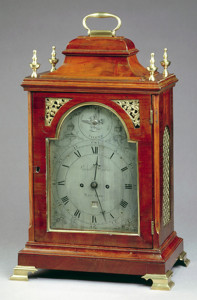
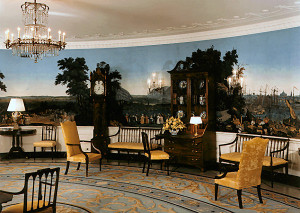
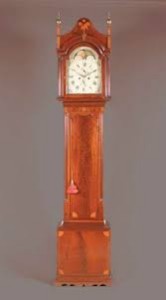
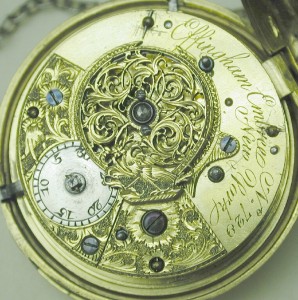
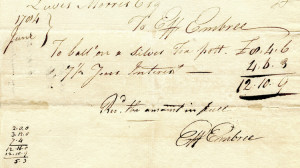
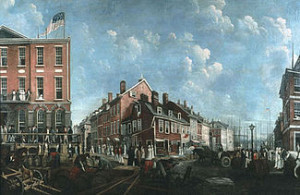
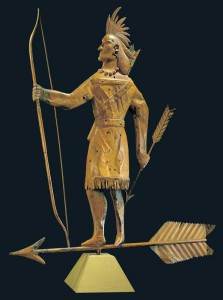
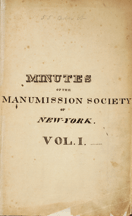
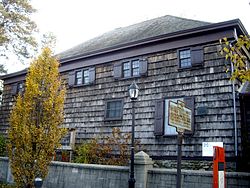
My ex-wife’s family lived in Port Chester N.Y. and when the grandmother moved in she brought her Effingham Embree tall case clock and Corinne Earle, the patrician grandmother told me it was once owned by James Fenimore Cooper. Cooper lived in Westchester near where my ex relatives lived in Harrison.
I’m a descendent, my great grandfather x7 was Effingham’s first cousin , Thomas Embree , who was a quartermasters in the Revolution and
Fought with the British and when they
lost the war, his people were exiled to
Nova Scotia , British owned, and his
descendants became quite famous buildings ships, lighthouses, schools etc.
in Port Hawkesbury, Cape Breton Island. We just visited Henry Ford Museum in Detroit and one of his tall
clocks is on premise and we got to take
some pictures with curator.
Effingham Embree is the 5th great grandfather of my daughter/law. Thank you for the article about his clocks. I had discovered his works while doing the genealogy of my family (including inlaws and some outlaws).
You’ve added more information that I will “borrow” to enhance my notes. Of course, you will be given the credit for this find.
Thank you.
Carol Rainey
I think the Lawrences’ decision that they were related to Lord Effingham is an amusing part of the family story. There was also a big con later involving a non-existent inductance of a billion pounds or so that was supposedly just waiting to be claimed by the relatives of Lord Effingham. I will write that up sometime.
Lee Podles